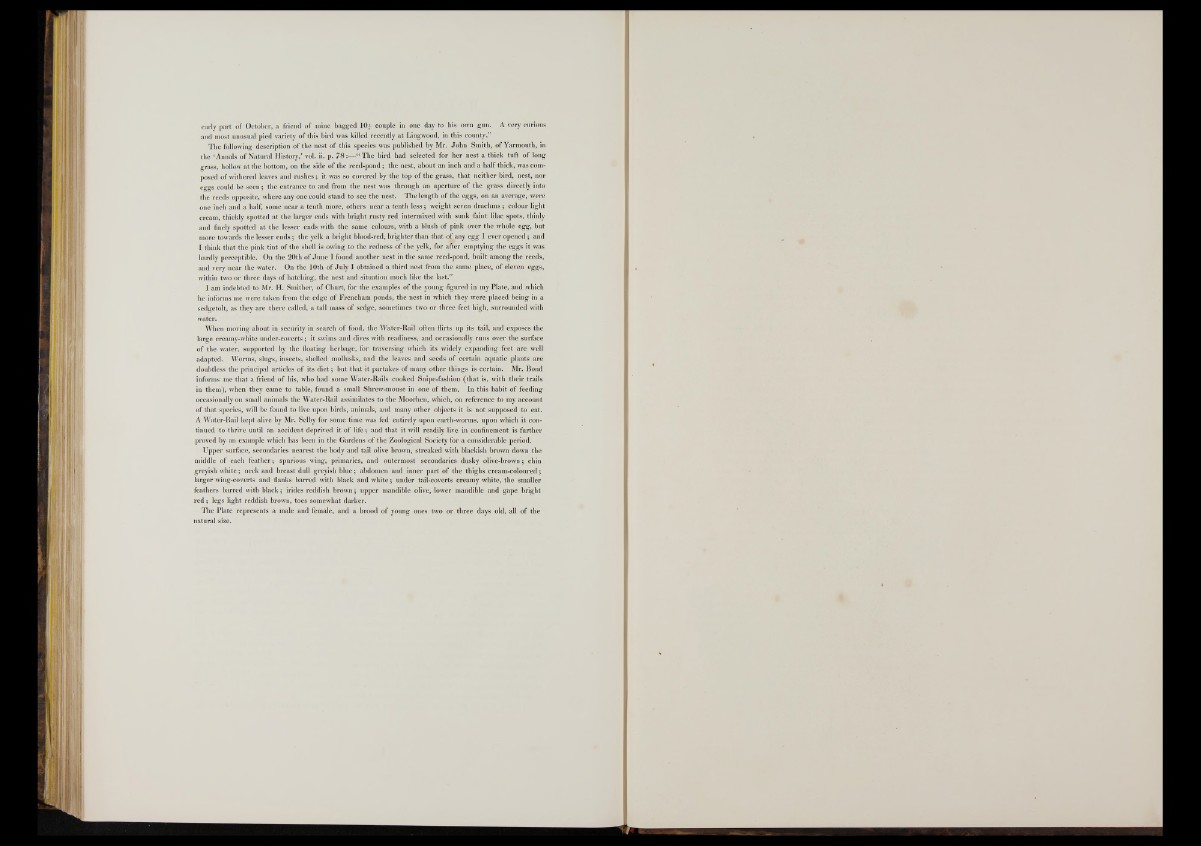
early part of October, a friend of mine bagged 1 0 i couple in one day to his own gun. A very curious
and most unusual pied variety o f this bird was killed recently a t Lingwood, in this county.”
The following description o f the nest o f this species was published by Mr. John Smith, of Yarmouth, in
the ‘Annals of Natural History/ vol. ii. p. 7 8 :— “ The bird had selected for her nest a thick tuft o f long
grass, hollow a t the bottom, on the side of the reed-pond; the nest, about an inch and a half thick, was com-
poséd of withered leaves and rushes; it was so covered by the top o f the grass, that neither bird, nest, nor
eggs could be se en ; the entrance to and from the nest was through an aperture o f the grass directly into
the reeds opposite, where any one could stand to see the nest. The length o f the eggs, on an average, were
one inch and a half, some near a tenth more, others near a tenth less; weight seven drachms; colour light
cream, thickly spotted at the larger ends with bright rusty red intermixed with sunk faint lilac spots, thinly
and finely spotted at the lesser ends with the same colours, with a blush o f pink over the whole egg, but
more towards the lesser en d s; the yelk a bright blood-red, brighter than that o f any egg I ever opened; and
I think that the pink tint o f the shell is owing to the redness o f the yelk, for after emptying the eggs it was
hardly perceptible. On the 20th o f June I found another nest in the same reed-pond, built among the reeds,
and very near the water. On the 10th o f July I obtained a third nest from the same place, o f eleven eggs,
within two or three days of hatching, the nest and situation much like the last.”
I am indebted to Mr. H. Smitlier, of Churt, for the examples o f the young figured in my Plate, and which
he informs me were taken from the edge of Frencham ponds, the nest in which they were placed being in a
sedgetolt, as they are there called, a tall mass of sedge, sometimes two or three feet high, surrounded with
water.
When moving about in security in search of food, the Water-Rail often flirts up its tail, and exposes the
large creamy-white under-coverts; it swims and dives with readiness, and occasionally runs over the surface
of the water, supported by the floating herbage, for traversing which its widely expanding feet are well
adapted. Worms, slugs, insects, shelled mollusks, and the leaves and seeds of certain aquatic plants are
doubtless the principal articles of its d ie t; but that it partakes o f many other things is certain. Mr. Bond
informs me that a friend of his, who had some Water-Rails cooked Snipe-fashion (th a t is, with their trails
in them), when they came to table, found a small Shrew-mouse in one o f them. In this habit of feeding
occasionally on small animals the Water-Rail assimilates to the Moorhen, which, on reference to my account
o f that species, will be found to live upon birds, animals, and many other objects it is not supposed to eat.
A Water-Rail kept alive by Mr. Selby for some time was fed entirely upon earth-worms, upon which it continued
to thrive until an accident deprived it o f life ; and that it will readily live in confinement is further
proved by an example which has been in the Gardens o f the Zoological Society for a considerable period.
Upper surface, secondaries nearest the body and tail olive brown, streaked with blackish brown down the
middle of each feather; spurious wing, primaries, and- outermost secondaries dusky olive-brown; chin
greyish white; neck and breast dull greyish blue; abdomen and inner p art o f the thighs cream-coloured ;
larger wing-coverts and flanks barred with black and wh ite; under tail-coverts creamy white, the smaller
feathers barred with black; irides reddish brown; upper mandible olive, lower mandible and gape bright
r e d ; legs light reddish brown, toes somewhat darker.
The Plate represents a male and female, and a brood of young ones two or three days old, all o f the
natural size.